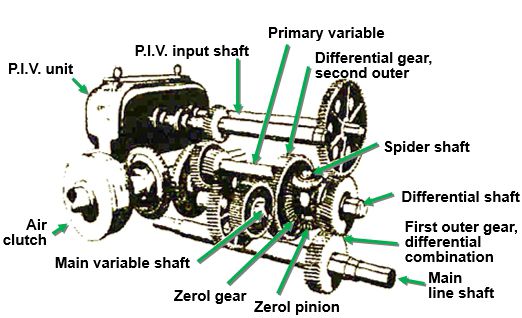Differential drive inspection - clutch, PIV, bearings and gears
Aug 27, 2019
The responsibility of setting the papermaking process in motion belongs to the differential drive. Its function is two-fold: (1) supply power to the individual machine sections, and (2) maintain a constant preset speed between those sections. The slightest speed difference between sections can result in a sheet break and lost production.
As a driving force behind the papermachine, the differential drive and its well-being are of high priority to operators and maintenance engineers. A good preventive maintenance program (PMP) is essential in preventing unexpected drive failure, which can result in production losses that far exceed equipment replacement costs.
No operation is immune to such surprise drive breakdowns. However, mills can reduce the chance of it occurring by educating personnel about the early warning signs of differential drive failure, and using annual inspections to analyze drive conditions and predict performance.
Durable design
The differential drive's workhorse reputation is for good reason. Depending on average speed, load, oil quality and frequency of maintenance, a differential drive can perform efficiently in excess of 40 years without requiring replacement gearing. This is an impressive feat considering the non-stop operational mode common to most papermachines.
However, where there is friction, there is wear - and eventually key drive components require adjustment or replacement.
Drive problems generally become evident by exhibiting an increase in noise and vibration levels. Because all drives generate a certain level of vibration, operators become in-tune to the "noise signatures" produced by the various components vibrating during normal operating and changing load/speed conditions. Once this operating noise or vibration varies outside of its normal limits, it tips-off the operator to a potential problem.
On-line or portable vibration monitoring systems are used to record "normal" equipment vibration signatures, which are compared with vibration signatures taken later. A comparison between the two signatures allows the operator or drive specialist to determine the severity of the problem.
Inspection - What to look for
Vibration monitoring and analysis of a differential drive problem is only part of the solution. Identification of drive components that are typically subject to wear can be evaluated and the appropriate action taken as part of an annual or two-year inspection program carried out during a normal, scheduled shutdown.
During this inspection, a drive specialist typically begins by zeroing in on three specific areas of the differential drive most susceptible to wear and ultimate failure: the clutch, the PIV, and the bearings and gears.

Differential drive components
Clutch
This key drive system component is subjected to high thermal loading and slippage during the engagement of machine sections, and requires periodic replacement.
The clutch, friction shoes and drum normally wear at a moderate rate. However, the cumulative wear will eventually cause erratic, unreliable performance that affects machine production efficiency.
Because high-inertia sections such as dryer sections tend to produce more clutch wear than such less energy-demanding sections as the fourdrinier, replacement of clutch wear components is more frequent at dryer drive locations.
PIV (Positively Infinitely Variable)
This mechanical variable-speed transmission enables the differential drive output shaft and the connected machine section speed to change in infinitely small increments over a particular range of speed.
PIV wear occurs primarily at the pin joints that hold the individual chain slat packets together, causing the chain to elongate. Chain elongation, if excessive, can affect the stability of the PIV output shaft speed. The differential output shaft speed and machine section speed are also affected, possibly increasing the number of sheet breaks.
Bearing and gears
Overloading and improper lubrication are the two main culprits associated with excessive bearing and gear wear. Badly worn, failing bearings tend to exhibit excessive clearance, which can shorten the life of associated gearing. In most cases, bearing clearance can be re-established to proper values depending on bearing type and element surface.
Gear tooth wear will result in additional backlash, which is not necessarily detrimental. However, once the geometry of the teeth is destroyed, the gears are unable to transfer the load smoothly, thus generating increased vibration and noise. Excessive tooth flank pitting can cause tooth failure, which, in turn, can force a machine shutdown.
Spare parts spare downtime
Any effective PMP will ultimately lead to replacement or repair of worn key drive components. Because these components have long lead time deliveries, most mills keep an inventory of critical replacement parts to help minimize the effects of costly downtime. Typically, component parts that can be ordered and delivered in 24 to 48 hours are not kept in inventory. The potential for an unexpected and catastrophic component failure will influence this inventory situation.
Unexpected drive failure can have far-reaching and damaging effects on a papermaking operation. Reducing the chances of it occurring is accomplished through an active PMP with properly trained personnel, the necessary vibration diagnostic equipment, and annual or two-year drive inspections performed by highly trained drive technicians.
Valmet takes care of your mechanical power transmission equipment. See the Related Links section of this web page for information about Valmet's spare parts for mechanical drives. For informative responses to your difficult drive-related maintenance questions, contact your Valmet representative.